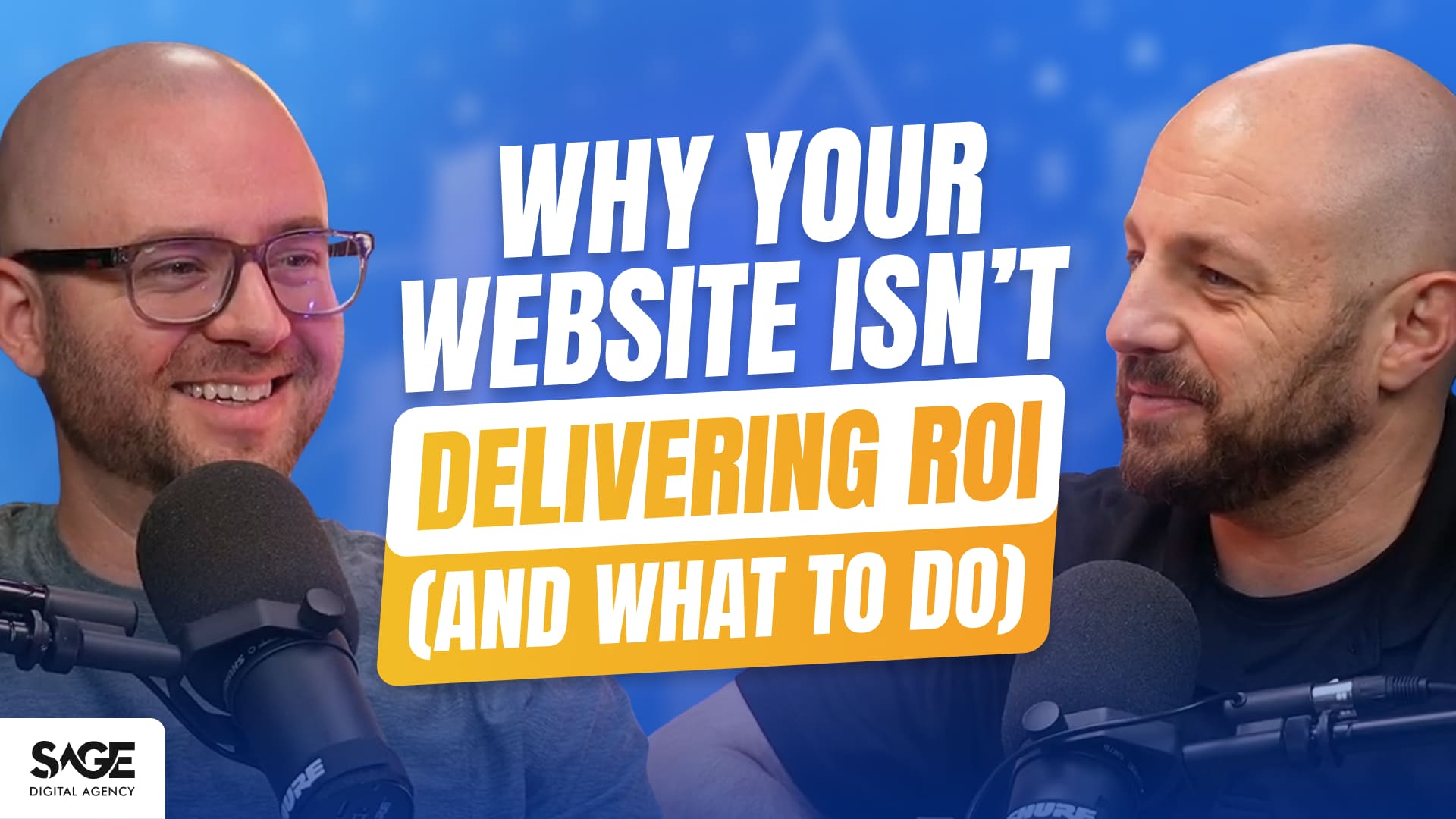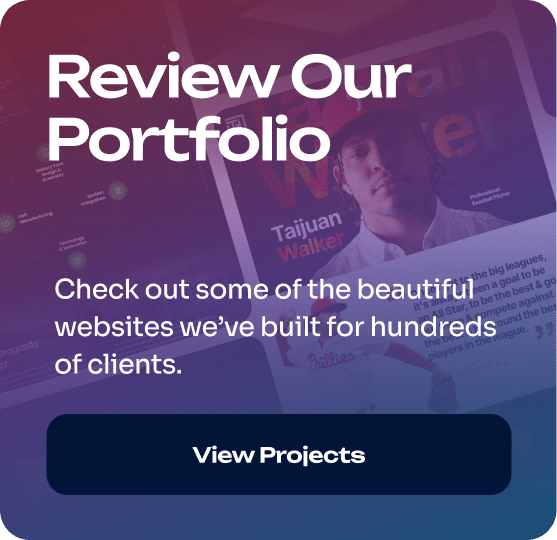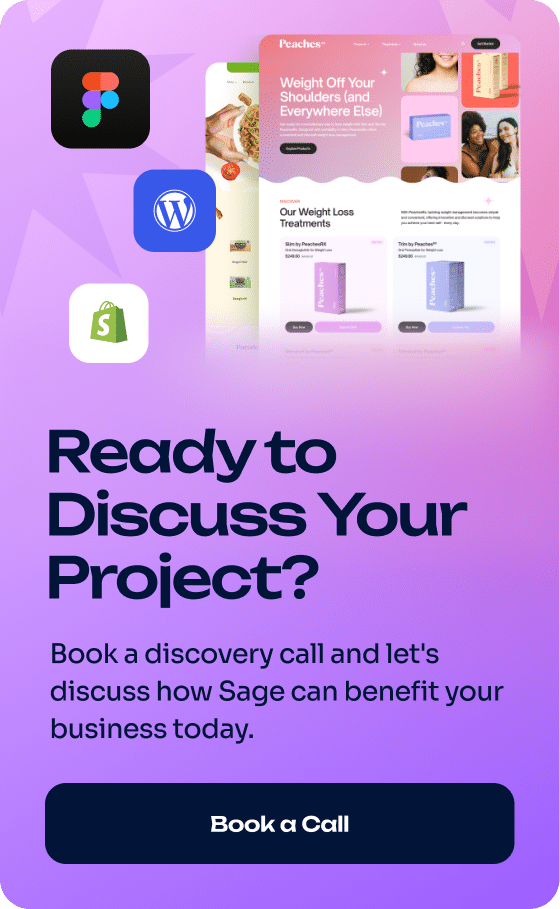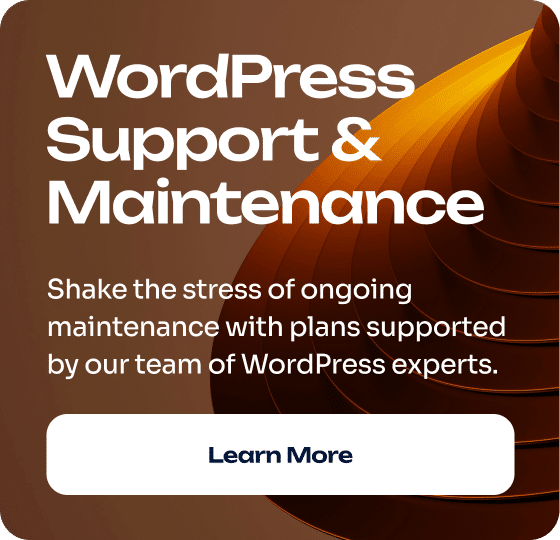Building a new website feels like a leap of faith. You know the current site isn’t working. Competitors are passing you by. But how do you justify spending $10,000, $20,000, or more on a project that might take months to complete?
Start by reverse-engineering the outcome you want. Most businesses approach website projects backward. They look at designs, compare prices, and hope for the best. Smart companies define their conversion goals first, then build everything else around those objectives.
Define Your Conversion Goals Before Anything Else
What do you want people to do when they land on your site?
This isn’t a philosophical question. You need one or two clear paths your ideal customer should follow. Fill out a contact form. Complete a purchase. Pick up the phone and call.
Think about a custom hot rod manufacturer. Their builds cost $300,000. They make 40% margin. That’s $120,000 profit per customer. Someone offered them a website for $900. That’s like offering to buy their $300,000 car for $25,000. The math doesn’t work.
When you understand the value of a single customer, website investment becomes obvious. A site that converts just one additional high-value client pays for itself immediately.
Map Your Customer Journey
Your website needs to guide people through specific actions. Start with your primary conversion path. For a digital agency, that might look like:
- Visitor reviews portfolio
- Visitor sees case studies and results
- Visitor books a consultation call
Secondary paths matter too. Someone might not be ready to buy today. Give them options to subscribe to your newsletter, download a resource, or follow you on social channels.
The attorney firm that neglected their website for years learned this the hard way. They relied on one partner’s personal network to bring in clients. That worked until that partner wanted to transition out. Without a digital presence capturing and converting leads, the business couldn’t sustain itself.
When Website Investment Actually Makes Sense
Not every business needs a custom website. If you’re selling cookies from your house, a template site works fine. But if you have real marketing spend, measurable customer lifetime value, or competitive pressure, you need something better.
Business Threshold Indicators
You should invest in a proper website when:
You’re spending money on marketing channels. If you’re running Google Ads, Meta campaigns, or any paid media, your website is where those clicks convert. A poorly optimized site wastes every dollar you spend driving traffic.
Your customer lifetime value justifies the investment. Calculate what one customer is worth over their relationship with your company. If that number is substantial, your website should be built to maximize conversions.
You need measurable results. Companies spending $200 per day or more on advertising need tight conversion tracking, proper analytics setup, and ongoing optimization. You can’t afford to guess.
One business owner said they were having “problems with Google Ads.” Their daily spend? Three dollars. That’s not a Google Ads problem. That’s a business strategy problem. At $3 per day, you might get one click. You can’t draw conclusions from that data.
The Real Cost of Cheap Websites
Someone will always offer to do it cheaper. The question is whether you’re comparing the same thing.
Two professionals came in for a consultation. Great meeting. Clear scope. Ten pages. Fair price. A few days later they said they got quotes from two other local companies. One quoted 25 pages. One quoted 20 pages. Both cheaper. Could we match it?
The scope changed completely. Why do you suddenly need 25 pages when we agreed on 10? And when you look at those vendors’ own websites, the quality difference is obvious. Would you be happy if your site looked like theirs?
Price only matters when you’re comparing equivalent outcomes. A $3,000 website might save you $2,000 compared to a $5,000 quote. But if it doesn’t convert visitors, doesn’t rank in search, and makes your business look unprofessional, you didn’t save anything. You wasted $3,000.
Choose Your Vendor Like You’re Entering a Marriage
Website projects aren’t five-hour commitments. These are substantial undertakings that can span years if done correctly. The relationship matters as much as the technical skills.
Questions That Reveal Vendor Quality
Who actually does the work? Many agencies have great salespeople who hand off projects to whoever is available. You want to work with the people who will build your site. Ask to meet them.
What’s their track record? Someone who has built 400 websites has seen every problem and solved it multiple times. First-timers will learn on your budget.
Do they practice what they preach? An SEO company that doesn’t rank organically is a red flag. A paid search agency without conversion tracking on their own site should terrify you. If they can’t do it for themselves, they won’t do it for you.
Will they push back on bad ideas? You hired experts. They should tell you when your requests will hurt the project. Yes-people who agree with everything aren’t helping you succeed.
What’s their approval process? You shouldn’t get too far down the line without seeing designs and giving input. Figma mockups let you approve the direction before development starts. This prevents expensive mistakes.
Red Flags to Avoid
Template pushers who change colors and swap your logo aren’t building custom solutions. Basement operations outsourcing to whoever is available that week can’t provide consistency. Sales-heavy pitches without substance usually mean the team can’t deliver.
Look at the vendor’s own website. That’s their best work. The site they had full control over. The project where they could showcase their abilities. If their site doesn’t meet your standards, yours won’t either.
Launch Your MVP and Iterate From Data
Minimum viable product doesn’t mean minimum quality. It means the best representation of your business you can launch now, built with room to grow.
You get the site live. You set up proper tracking and analytics. Then you watch what actually happens. Real user behavior tells you what to optimize next.
Setting Up for Measurement Success
Proper tracking setup is non-negotiable. One company was spending $40,000 per month on Meta ads without basic conversion tracking installed. How do you make decisions without data?
A few hours of consulting up front ensures everything is configured correctly. The cost is negligible compared to the wasted ad spend from flying blind.
Heat maps show you where people actually look and click. You might build a beautiful homepage and discover only 10% of visitors scroll past the first 20%. The bottom 80% of that page might as well not exist.
Form submission tracking reveals friction points. If half your visitors reach your contact form but don’t submit, something is wrong. The fields might be confusing. The ask might be too big. The data tells you where to focus.
Data-Driven Improvement Framework
Launch with analytics in place. Give it time to collect meaningful data. Look for patterns in:
Bounce rates by page. If 50% of people hit your service page and leave after five seconds, you have a problem. Either the wrong people are coming to that page, or your content isn’t resonating with the right people.
Conversion path analysis. Where do people drop off in your funnel? Every exit point is an optimization opportunity.
Time on page metrics. Pages with high engagement and low conversion need different fixes than pages with low engagement.
Heat map insights. What are people actually clicking? What are they ignoring? Your assumptions about important page elements might be completely wrong.
Testing happens after you have enough data to make decisions. Change one element at a time. Measure the result. Keep what works. Discard what doesn’t.
Ongoing Engagement Models That Make Sense
The relationship doesn’t end at launch. Different businesses need different levels of ongoing support.
The minimal engagement: hosting and health monitoring. The site stays online, secure, and functional. You handle everything else. This works for businesses with internal marketing teams who just need reliable infrastructure.
Mid-level: a few hours per month for growth planning and strategic consulting. Someone keeping an eye on performance, suggesting improvements, helping you think through decisions. This prevents wasted effort on tactics that won’t work.
Full service: continuous optimization plus paid media management. For businesses spending serious money on advertising, you need someone managing campaigns, analyzing results, and improving conversion rates constantly.
Choosing the Right Level of Support
Your ad spend dictates your needs. If you’re spending a couple hundred dollars a day or more, you need active management. That volume of traffic generates enough data to optimize meaningfully. Spending $3 per day? You don’t need an agency. You need a different approach entirely.
The vendor relationship should feel like having an experienced advisor on call. Someone who will tell you straight when an idea won’t work. Who brings suggestions based on what has worked for similar businesses. Who won’t constantly upsell you on things you don’t need.
Roadmapping sessions help even if you don’t implement everything immediately. Understanding what you should do, in what order, with what resources prevents expensive mistakes. The consulting cost is minimal compared to wasted budget on tactics that were never going to deliver results.
How to Actually Measure Website ROI
Measuring return on investment requires tracking multiple metrics across different time horizons. Some results are immediate. Others compound over months.
Immediate Performance Improvements
Visual and functional upgrades are the first measurable wins. An outdated site from 10 years ago looks obviously bad. The improvement is undeniable. Professional design signals that you care about your business. It affects trust before a single word is read.
Performance scores matter for user experience and search rankings. A site that loads in two seconds converts better than one that takes seven. Mobile responsiveness isn’t optional anymore. Google penalizes sites that don’t work on phones.
These improvements are table stakes. They don’t directly generate revenue, but they remove barriers to conversion.
Conversion Rate Optimization Delivers Measurable Returns
Small percentage improvements in conversion rates create substantial ROI when you’re driving significant traffic.
Send 1,000 visitors to your site. A 2% conversion rate gets you 20 leads. A 3% conversion rate gets you 30 leads. That’s 50% more leads from the same traffic. If you’re spending $5,000 per month on advertising, you just got 50% more return on that investment.
When you improve conversion rates, you get more leads for less money. Your cost per acquisition drops. Your marketing budget goes further. The website investment pays for itself quickly when conversion improvements are meaningful.
Organic Search Performance Compounds Over Time
Rankings don’t improve overnight. SEO is a long game. But organic traffic is the gift that keeps giving.
Content marketing combined with technical optimization drives rankings. One agency has seen organic growth from doing nothing to their website’s code except posting to social media regularly and publishing blog content. Social activity correlates with organic rankings. Search engines notice signals of authority and engagement.
Hundreds of monthly visitors now come from prompting large language models like ChatGPT. Those AI systems recommend the agency based on their content library. Those recommendations convert into real clients. This wouldn’t happen without substantial, high-quality content published consistently.
Track organic ranking improvements for your target keywords. Monitor organic traffic growth month over month. Measure qualified leads from organic sources separately from paid channels. This shows you the compounding value of content investment.
Business-Specific KPIs Vary by Industry
Every business has different success metrics. Some care about awareness and brand recognition. Others need direct revenue attribution.
For e-commerce, it’s straightforward. Revenue per visitor, average order value, cart abandonment rate, repeat purchase rate. The numbers connect directly to profit.
For service businesses, it’s softer. Consultation bookings, qualified lead volume, sales cycle length, close rate on website-sourced leads. You might not close business immediately, but you can track how website leads progress through your pipeline.
For local businesses with both digital and offline marketing, attribution gets complicated. You need to ask new customers how they found you. Track direct traffic spikes after offline campaigns. Use unique phone numbers for different channels to measure call volume.
The key is defining what matters for your business model and tracking it consistently. Don’t measure vanity metrics that make you feel good but don’t connect to revenue.
Content as Fuel for Sustainable Growth
Your website is the hub. Content feeds every marketing channel and multiplies your expertise across platforms.
The Content Multiplication Strategy
Record 90 minutes of video content in one session. That’s not asking for four days per month in a studio. One focused session with pre-planned topics and questions produces:
- Three full YouTube videos for long-form content
- 35 to 40 short-form clips for social media distribution
- Transcripts for blog posts optimized for search and LLMs
- Sales enablement assets answering common questions
- Email campaign content for nurture sequences
- Creative assets for paid advertising campaigns
This is human editing and strategic repurposing, not AI batch processing. Each piece of content serves a specific purpose across different channels.
Why Video Content Matters Now
The days of nameless, faceless organizations are over. People want to see who they’re working with. They want to know you can speak intelligently about relevant topics. They want trust signals before they ever contact you.
Someone researching vendors will look at your website. They’ll Google your name. They’ll check your social profiles. If they find nothing, or worse, find outdated and neglected content, you’re eliminated from consideration. You might never know they visited.
Original video content establishes authority. You’re demonstrating expertise, not claiming it. Someone watching you explain complex topics for 10 minutes learns more about your capabilities than reading any amount of marketing copy.
Overcoming Camera Hesitation
Not everyone is comfortable on camera. That’s normal. But it’s not a valid reason to skip content creation entirely.
Interview format makes it easier. Have someone ask you questions. Answer them naturally. You don’t need to memorize scripts or deliver perfect takes. Editing handles mistakes and awkward pauses.
The more planning you do up front, the better the outcome. Know what topics you’ll cover. Prepare a few key points for each. But don’t over-script. Natural conversation is more engaging than rehearsed speeches.
You’re not trying to be a YouTube celebrity. You’re building trust with potential customers who are evaluating whether to work with you. That’s a much lower bar. Just be knowledgeable and authentic.
Content Distribution Across Channels
Create once, distribute everywhere. Long-form YouTube videos live on your channel. Short clips go to Instagram, Facebook, TikTok, and LinkedIn. Transcripts become blog posts for your website.
Blog posts optimized for both traditional search engines and large language models increase your digital footprint. Google still drives traffic. But ChatGPT, Claude, and other AI systems are becoming research tools. Getting recommended by these systems brings highly qualified visitors.
Paid media benefits from original content. Instead of generic stock photos and written ads, you’re using video clips of yourself explaining your value proposition. Conversion rates improve when people see a real person behind the business.
Sales teams use video content to answer questions without repeating themselves. “You asked about our process? Watch this three-minute video that explains exactly how we approach projects.” This qualifies leads before you spend time on calls.
Making the Investment Decision
You need a new website. You know the current situation isn’t working. How do you justify the expense to stakeholders?
Building the Business Case
Calculate customer lifetime value. If one new customer is worth $50,000 over three years, your website needs to generate one additional customer to pay for itself. That’s a low bar for a site that will serve you for years.
Factor in efficiency gains. If your current site requires manual workarounds, staff time spent on problems, or lost opportunities from technical limitations, those costs are real. A properly built site eliminates that friction.
Consider competitive positioning. Your competitors have modern, professional sites. You don’t. Every potential customer comparing options sees that difference. How much business are you losing to better-presented alternatives?
Include opportunity cost. What could you do with a website that actually supports your marketing efforts? How much faster could you grow with proper conversion optimization? The cost isn’t just what you spend on the site. It’s what you’re leaving on the table by not having it.
Choosing Investment Level
A $5,000 website and a $20,000 website serve different business needs. The cheaper option might work for a small local business with limited marketing. It won’t work for a company spending six figures annually on advertising.
Match your website investment to your marketing spend and customer value. If you’re spending $5,000 per month on ads, a $3,000 template site is a terrible decision. Your marketing budget will underperform because conversions leak at every step.
If you’re spending $50,000 annually on advertising, a $15,000 website investment is 30% of your annual ad spend. If it improves conversion rates by even 20%, it pays for itself in the first year. Every year after that is pure return.
Timeline and Expectation Management
Website projects take time. Expect 8 to 12 weeks from kickoff to launch for a custom site with 10 to 15 pages. Rushing the process produces worse outcomes. Complex sites with custom functionality take longer.
Results don’t happen on launch day. It takes time for search engines to index new pages and content. Paid media campaigns need data to optimize. Organic rankings build over months, not days.
Set realistic expectations about what happens when. Immediate wins come from improved user experience and conversion optimization. Medium-term wins come from paid media performance improvements. Long-term wins come from organic search growth and compounding content effects.
The best website projects are partnerships spanning years. You launch. You measure. You improve. You adapt to market changes. The vendor becomes an extension of your team, not a one-time contractor.
Common Mistakes That Kill ROI
Even with the right vendor and reasonable budget, projects fail when businesses make preventable mistakes.
Skipping Proper Tracking Setup
Launching without analytics and conversion tracking means flying blind. You can’t measure ROI if you’re not measuring anything.
Basic setup includes Google Analytics properly configured, conversion goals defined and tracked, heat mapping tools installed, and form submission tracking verified. This takes a few hours up front. Skipping it wastes months of potential optimization.
One company spending $40,000 per month on Meta advertising didn’t have basic Facebook Pixel setup completed. They were burning budget without knowing which campaigns, ads, or audiences performed best. A few hours of consulting would have saved them thousands in wasted spend.
Focusing Only on Price
The cheapest option is expensive when it doesn’t work. You’ll spend money twice. Once on the cheap vendor. Again on the qualified vendor who has to fix everything.
Compare scope, not just price. A quote for 25 pages versus a quote for 10 pages aren’t comparable. Evaluate what you’re actually getting. Look at the vendor’s portfolio. Ask about their process and team.
Judge vendors by outcomes, not cost. The $15,000 website that converts 3% of visitors delivers better ROI than the $5,000 website that converts 1%. You make more money with the expensive site.
Neglecting Ongoing Optimization
Launching is the beginning, not the end. Websites need continuous improvement to stay competitive and effective.
Competitors update their sites. They add features, improve messaging, and optimize conversion paths. If you launch and ignore your site for two years, you’ll fall behind again.
Market conditions change. Customer expectations evolve. New technologies emerge. A site that worked great at launch needs adaptation to stay relevant.
Budget for ongoing support from the start. Even minimal engagement keeping the site healthy and secure is better than launching and disappearing. Active optimization compounds results over time.
Ignoring Your Vendor’s Advice
You hired experts. Listen to them. They’ve built hundreds of sites. They know what works and what doesn’t.
Sometimes clients demand features or design choices that will hurt performance. A qualified vendor should push back and explain why. If you override their professional judgment, you’re paying for expertise and then ignoring it.
The best client relationships have mutual respect. You know your business. They know websites and marketing. Collaboration produces better results than dictating every detail or deferring every decision.
Frequently Asked Questions
How much should I budget for a professional business website?
Budget depends on your business size and marketing spend. Small local businesses with limited marketing might spend $5,000 to $10,000. Mid-size companies with active marketing should expect $15,000 to $30,000 for custom design and development. Businesses spending six figures annually on advertising might invest $40,000 or more for complex functionality and integrations. Match your website investment to your customer lifetime value and marketing budget, not arbitrary price points.
What timeline should I expect for a custom website project?
Custom websites typically take 8 to 12 weeks from project kickoff to launch. This includes discovery, design mockups in Figma, client approval cycles, development, content population, testing, and deployment. Complex sites with custom functionality, integrations, or large page counts may take 16 to 20 weeks. Template-based sites can launch faster but offer less customization. Rushing the process usually produces worse outcomes because proper design and testing can’t be compressed.
How do I know if my website is actually generating ROI?
Track conversion rates, cost per lead from paid channels, organic traffic growth, and qualified lead volume. Set up proper analytics before launch to establish baselines. Measure improvement in bounce rates, time on site, and form submission rates after redesign. For e-commerce, track revenue per visitor and average order value. Compare your cost per acquisition before and after optimization. A successful website should show improving conversion metrics over 6 to 12 months as you optimize based on real user behavior data.
What ongoing costs should I expect after website launch?
Minimum ongoing costs include hosting, security updates, and technical maintenance. This might run $100 to $300 monthly depending on your site’s complexity and traffic. Most businesses benefit from some level of optimization support. A few hours monthly for strategic consulting and minor updates might cost $500 to $1,500. Active optimization with content creation, conversion testing, and analytics review runs $2,000 to $5,000 monthly. Companies with significant paid media spend need active management and should budget accordingly.
Should I use a template or custom design for my website?
Template sites work for very small businesses with limited marketing budgets and simple needs. If you’re selling products locally with minimal online marketing, a template might suffice. Custom design makes sense when you have real marketing spend, need specific functionality, want to stand out from competitors, or require integration with business systems. If you’re spending $5,000 or more monthly on advertising, a custom site built for conversion optimization will deliver better ROI than any template.
How important is mobile optimization for business websites?
Mobile optimization is mandatory, not optional. Over half of web traffic comes from mobile devices in most industries. Google’s mobile-first indexing means your mobile site performance affects search rankings. A site that doesn’t work on phones will have terrible conversion rates, high bounce rates, and lost business. Responsive design that adapts to any screen size is standard practice. Sites that still require zooming and sideways scrolling on phones lose customers to competitors with better mobile experiences.
What’s the difference between a $3,000 website and a $15,000 website?
A $3,000 website is typically template-based with minimal customization, limited pages, stock photos, generic content, and basic functionality. A $15,000 website includes custom design specific to your brand, strategic conversion optimization, professional copywriting, custom photography or video, advanced functionality and integrations, comprehensive SEO setup, and proper analytics implementation. The cheap site might look acceptable. The expensive site is built to generate business results through strategic planning and professional execution across all elements.
How do I choose between multiple website vendors with different pricing?
Look beyond price at scope, quality, and team experience. Review each vendor’s portfolio and their own website. Ask who will actually do the work and about their process. Check how many projects they’ve completed. Understand what’s included in each quote – compare equivalent scopes, not just numbers. The cheapest option is expensive if it doesn’t work. The most expensive option isn’t necessarily the best. Choose based on proven results, process quality, team expertise, and alignment with your business goals. Request references from similar businesses they’ve served.
Can content marketing really drive measurable business results?
Content marketing drives results through multiple channels. SEO-optimized blog posts improve organic search rankings over time, which generates free qualified traffic indefinitely. Video content establishes expertise and builds trust with prospects before they contact you. Social media content increases visibility and engagement, which correlates with search rankings. Content repurposed across channels maximizes the value of each piece created. Large language models like ChatGPT now recommend businesses based on published content, driving highly qualified traffic. The key is consistency and quality, not one-time efforts.
What should I do if my current website isn’t generating leads?
Start with analytics to understand the problem. Low traffic means you have a visibility issue – improve SEO and increase marketing. High traffic but low conversion means your messaging, design, or user experience needs work. High bounce rates on specific pages indicate content problems. Run heat maps to see where users are clicking and scrolling. Check your conversion path for friction points. Verify your tracking is working correctly. Get an outside perspective from someone experienced in conversion optimization. Sometimes small changes to forms, CTAs, or page layout dramatically improve results without a full redesign.
Key Takeaways
Reverse engineer your website from business goals, not design preferences. Define one or two clear conversion paths before thinking about aesthetics. Know what you want visitors to do and build everything around those actions.
Match website investment to customer lifetime value and marketing spend. If your customers are worth tens of thousands of dollars over their lifetime, and you’re spending significantly on marketing, your website should reflect that level of investment.
Choose vendors based on their work, process, and team, not price alone. Review their portfolio, understand who will actually do the work, verify they practice what they sell, and ensure they’ll push back on bad ideas with professional expertise.
Launch with proper analytics and iterate based on real user behavior. Set up comprehensive tracking before launch, give it time to collect meaningful data, identify optimization opportunities from actual usage patterns, and test changes systematically.
Plan for ongoing optimization, not just one-time project completion. Budget for hosting, security, and maintenance at minimum. Consider strategic consulting monthly to guide growth. Active optimization compounds results over time for businesses with significant marketing.
Create video content and repurpose it across all marketing channels. One 90-minute session produces dozens of content pieces for YouTube, social media, blog posts, sales enablement, email campaigns, and paid advertising. This multiplies your expertise and builds trust at scale.
Measure ROI through conversion rates, organic growth, and qualified lead volume. Track performance metrics that connect to revenue, not vanity metrics. Compare cost per acquisition before and after improvements. Monitor organic search growth as a compounding asset over time.





